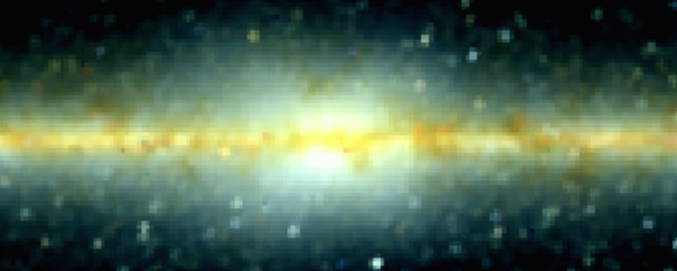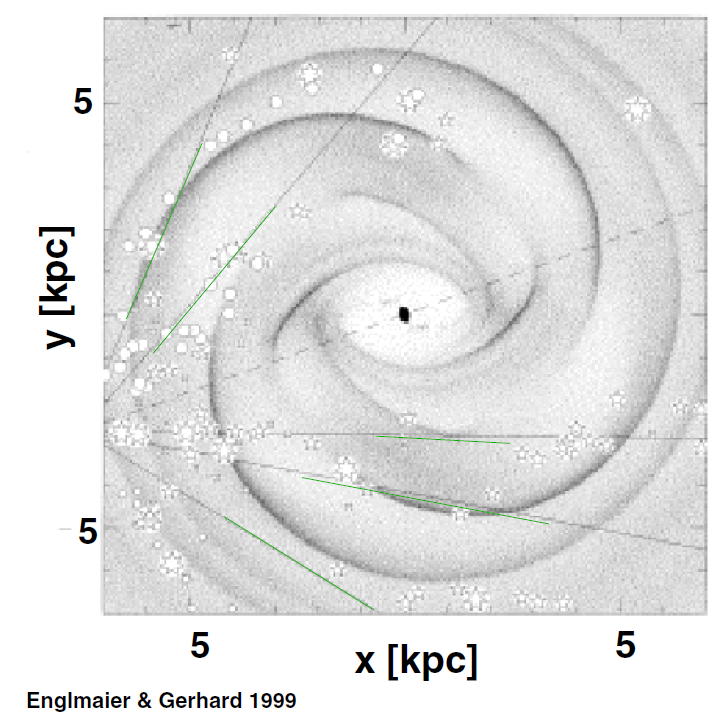
The bulge: photometric 3D models, bulge/disk models and mass
 المؤلف:
Heino Falcke and Friedrich W Hehl
المؤلف:
Heino Falcke and Friedrich W Hehl
 المصدر:
THE GALACTIC BLACK HOLE Lectures on General Relativity and Astrophysics
المصدر:
THE GALACTIC BLACK HOLE Lectures on General Relativity and Astrophysics
 الجزء والصفحة:
p 47
الجزء والصفحة:
p 47
 24-1-2017
24-1-2017
 3117
3117
The bulge: photometric 3D models, bulge/disk models and mass
The bulge in the Milky Way could be seen either as the inner part of the Galactic halo or as the outer part of the Galactic bar. The properties of its stellar population are not easy to determine, since the extinction to this region is generally high. ‘Baade's window’ is an exception, a region at Galactic latitude b ≈ −4o, where the extinction happens to be low. Thus, up to a short time ago most observations of the stars in the bulge were made either in Baade's window or other regions at high Galactic latitude (|b| > 3o). These observations showed that the bulge in the Milky Way closely resembles other spiral bulges or moderately luminous E or S0 galaxies (e.g. Whitford 1978). Light in the near infrared (NIR) region of the spectrum, at wavelengths of ∼1.2–2.2 μm, is dominated by old middle and late-type M giant stars (Blanco et al 1984). Thus, the overall photometric and spectroscopic properties of the Galactic bulge are like those of early-type galaxies, dominated by old and metal-poor population II stars, similar to what is found in the Galactic halo.
However, more detailed studies find a gradient in the metallicity (Tiede et al 1995), with rising metal content in the direction of the Galactic Center. At the center itself, the metallicity is Solar or higher. Recent NIR observations that came as close as 0.2o to the Center revealed evidence for a bright, young stellar population that can be found only in the inner ∼1◦ and quickly declines with increasing radius (Frogel et al 1999).
To be able to analyze the structure of the bulge in the Milky Way and draw


Figure 1.1. The bulge of the Milky Way as it appears from the Earth at NIR wavelenths (composite image at 1.25, 2.2 and 3.5 μm spanning 60o in Galactic longitude from the DIRBE instrument aboard the COBE satellite).
conclusions about the existence of a triaxial structure, we need to overcome a problem similar to that encountered when trying to derive the spiral structure: if we see the bulge region at all (i.e. at NIR and longer wavelengths), we see it edge-on. Thus, the observed surface brightness distribution has to be deprojected to derive the photometric structure of the bulge. This has been done based on dust corrected maps from the COBE satellite (DIRBE instrument, in the L (3.5 μm) or K(2.2 μm) band). Then, it is possible to model the 3D structure of the bulge and also investigate the consequences the shape of the bulge may have on the non-axisymmetric structure of the disk.
This has been done by, e.g., Binney et al (1997), based on a deprojection algorithm developed by Binney and Gerhard (1996). They first obtained a best fit to the observed structure, starting with an analytic model which was improved by using a Richardson–Lucy deconvolution algorithm. The best fit was then deprojected. The result is a clearly and robustly triaxial object with a best-fit axis ratio of 1 : 0.6 : 0.4 and dimensions of 1.8 kpc (major axis) by 1 kpc (minor axis). The angle φ between the Sun, the Galactic Center and the long axis of the bulge is also a free parameter of the fit; it turns out to be (again robustly) small: φ ∼ 20o. Another parameter of the model is the position of the Sun above or below the plane of the Milky Way, which is 14 ± 4 pc above the plane. Close to the Center, the radial brightness profile is well approximated by a power law, but the ‘barred bulge’ seems to be embedded in a thin elliptical disk 3.5 × 2.0 kpc in size. The bar has a pattern speed of ΩP ∼ 60–70 km s−1. At a radius of ∼3 kpc, there is a secondary brightness maximum along the y-axis that may be related to the 3 kpc spiral arm.
Similar deprojections and models by other authors (e.g. Freudenreich 1998) have arrived at compatible results.
A slightly different approach was taken by Fux (1997). He used the COBE/DIRBE K-band map to select the best models out of a large number of stellar dynamical simulations. The models contain a ‘nucleus-spheroid’ component which represents the bulge, a double-exponential disk and an oblate exponential halo. They extend out to a radius of 10 kpc.
The agreement with Binney et al's results is good: Fux finds φ = 28o ± 7o, ΩP = 55±5 kms−1 and a bar corotation radius of 4.3±0.5 kpc, which constitutes a firm upper limit to the possible bar size. His bar axis ratio is ∼0.5.
Examining the families of models, it is found that at a late enough time a bar instability always forms indeed, in numerical simulations it is very easy to produce persistent bars, some of which are due to numerical effects. Spiral structure is far more rarely seen in these models and, if it appears, it is very short lived. This is partly due to the fact that the models investigated so far are pure stellar dynamical ones, which do not take the influence of a gaseous component into account. Even though most of the mass resides in the stars, gas can have a large effect on the structure that emerges from a model, since it is the coldest, most dissipative component of a galactic system, reacting most readily to perturbations. However, models including gas dynamics are more difficult to realize than purely stellar dynamical calculations.
Still, recently a number of authors have presented bulge/disk models which include gas dynamics (Englmaier and Gerhard 1999, Fux 1999, Weiner and Sellwood 1999). Englmaier and Gerhard calculate quasi-equilibrium flow solutions in the gravitational potential of the deprojected COBE NIR bulge/bar and disk. Their models extend out to a radius of 7 kpc. The best models not only confirm again the barred bulge of the earlier deprojections, with φ = 20o–25o, ΩP = 55 km s−1 and a corotation radius of 3.5±0.5 kpc; they also quantitatively reproduce the location of the spiral arm tangents determined by a variety of tracers inside the solar circle, spiral arm locations that we have already encountered as the most certain features of the Milky Way spiral structure. The proposed four-armed spiral structure is clearly confirmed and even more pronounced if an additional spiral arm potential is included. A sample model is shown in figure 1.2.
Another assumption mentioned earlier is also supported by gas dynamical modelling: this is the maximal disk, i.e. a maximal mass-to-light (M/L) ratio, constant for the NIR bulge and disk, that is compatible with the rotation. The implication of this is that the dark matter contribution to the mass in the inner galaxy is small.
We can be fairly certain that the bulge indeed has a triaxial structure since many independent determinations arrive at very similar results. But we have not said anything so far about one very fundamental parameter of the bulge: its mass. ‘Conventional’ mass determinations based on NIR brightness and a constant M/L ratio yield Mbulge = (1.6-2.0) × 1010 Mּ. This already takes into account the barred, triaxial shape determined earlier.
Interestingly, it is possible that these mass determinations may be contradicted by bulge microlensing experiments. In such experiments, millions of


Figure 1.2. A combined gas-dynamical model of the bulge and the disk, including the influence of the dark halo (from Englmaier and Gerhard 1999), calculated with 100000 particles. The spiral arm tangents are marked; they are well matched by the model which clearly results in a four-armed spiral.
(bulge) stars are monitored for brightness variations. True microlensing events are characterized by symmetric light curves that are independent of color a secure criterion for distinguishing a microlensing event, when light from a background star is amplified by the close passage of an (unseen) lensing star, from an intrinsically variable star. Microlensing data, which are now based on good statistics and ten years of observations, are collected for a number of purposes, among them the search for Massive Compact Halo Objects (MACHOs) as possible contributions to dark matter and the search for planetary systems. They yield an ‘optical depth’ toward the bulge of τ = (2-3)×10−6 (Alcock et al 2000) for microlensing.
While this is certainly a small value, it is too high to be compatible with bulge masses determined by the standard method (Binney et al 2000, Gyuk 1999). It seems that a bulge mass of 2.5 × 1010Mּ is required by the microlensing data, which possibly does not agree with any realistic bulge model, though Blum (1995) finds a mass of 2.8 × 1010Mּ for very special parameters within the framework of a barred stellar distribution. However, in his model the pattern speed required is uncomfortably high; lower values of ΩP reduce Mbulge.
It remains to be seen whether these concerns will result in an upward correction to the bulge mass. Alternatively, it is of course always possible (though not very satisfying) to assume that our line-of-sight toward the bulge is not quite typical.
 الاكثر قراءة في الثقوب السوداء
الاكثر قراءة في الثقوب السوداء
 اخر الاخبار
اخر الاخبار
اخبار العتبة العباسية المقدسة


